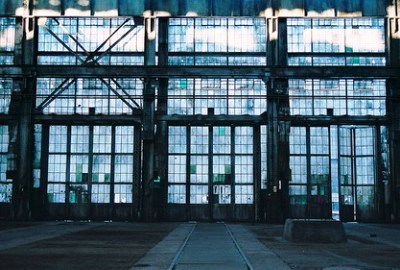
The Albuquerque Rail Yards are a massive complex sprawling over 27.3 acres and sitting (mostly) idle off 2nd St. in the old Barelas neighborhood. Established by the Atlantic and Pacific (A & P) railroad in 1880 after Albuquerque was designated as the division point between the A & P and Santa Fe Railways, the chief function of the complex was to maintain and repair locomotives. However, most of the shops and offices were constructed between 1914 and 1924, by which time the Santa Fe Railway, following bankruptcy in 1883, had re-emerged as the Atchison, Topeka and Santa Fe Railway, absorbed the A & P, and gained ownership of the yards. By 1919, one-quarter of Albuquerque’s work force was employed at the rail yards and most of the city’s commerce owed its existence to the railroad. At present, there are 14 buildings, mostly clustered in the northern part of the yards; to the south is an operational turntable, built in 1915, which was used to rotate trains as they entered or exited.

(Photo above is facing southeast from the roof of the machine shop toward the turntable. Photo below was taken in the blacksmith shop.)
Of the buildings constructed between 1914 and 1915, only the 35-stall roundhouse and a storehouse stand, while buildings for freight car repairs and a powerhouse have been demolished. However, one of the unique things about the Albuquerque Rail Yards is its state of preservation; virtually every building built from 1916 onward remains, including flue (1920), boiler (1923), blacksmith (1917), and machine (1921) shops, an assembly hall (1922), a firehouse (1920), and a car garage (pre-1931), among others.
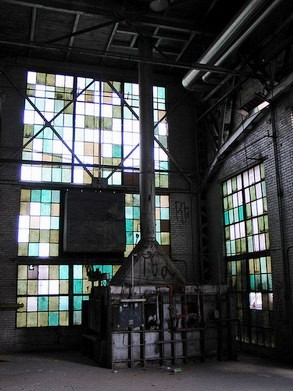 The rail yard’s buildings were at the forefront of industrial technology and the 165,000 sq. ft./3.8 acre machine shop has been considered comparable to the 1922 Ford Motor Company Glass Plant, which scholar Grant Hildebrand said was "the single factory which carried industrial architecture forward more than any other." For example, the machine shop’s two-story traveling cranes, one of which could hoist 250 tons, were incorporated into the structure of the building itself. Further, all rail lines, whether inside or outside buildings, ran north-south while a transfer table (pre-1919) for moving locomotives between buildings ran east-west, as did the overhead cranes. Thus the rail yard was sturdy and highly-efficient, with the massive locomotives moved easily from one area to another.
The rail yard’s buildings were at the forefront of industrial technology and the 165,000 sq. ft./3.8 acre machine shop has been considered comparable to the 1922 Ford Motor Company Glass Plant, which scholar Grant Hildebrand said was "the single factory which carried industrial architecture forward more than any other." For example, the machine shop’s two-story traveling cranes, one of which could hoist 250 tons, were incorporated into the structure of the building itself. Further, all rail lines, whether inside or outside buildings, ran north-south while a transfer table (pre-1919) for moving locomotives between buildings ran east-west, as did the overhead cranes. Thus the rail yard was sturdy and highly-efficient, with the massive locomotives moved easily from one area to another. 
(Photo above is of the machine shop, taken from the northwest of the building, with cranes at the far end.)
Albuquerque’s early designation as a division point was important because it ensured that the most significant railroad activity in the region would be centered in the city, with the next-nearest division points located in Las Vegas (north), Gallup (west), and San Marcial (south). In the late 1800’s and early 1900’s, a locomotive generally left for a one-way trip of only 100-150 miles in the morning, underwent some basic repairs upon arrival, and then returned later in the day to its home shop for further maintenance. Fire tubes, flues, smoke boxes, and boilers all had to be cleaned daily and ash residue left behind by incompletely burnt coal had to be continually removed.
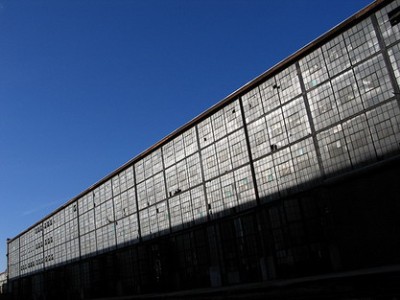
(Photo above is of the boiler shop as seen from the transfer table, which sits between the boiler and machine shops.)
While early locomotives only managed 40,000 miles between major repair-work, 20th Century engines routinely did 400,000 miles, which put them in the shop for a complete overhaul every year or year-and-a-half. Shops such as those at the Albuquerque Rail Yard completely dismantled locomotives, painstakingly cleaning each part of the engine, lathing wheels, manufacturing replacement equipment, patching and mending and then testing and inspecting the entire engine before sending it back out. A well-cared-for engine might last 15 years and, at its peak, the rail yards tore down and re-built about 40 a month.
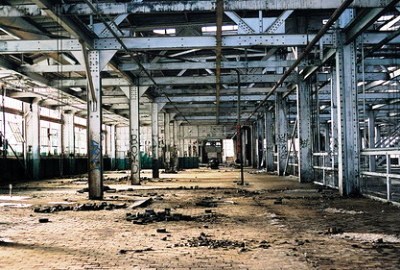
(Photo above was taken on the second floor of the machine shop. Note the wooden "bricks," which reduced damage to dropped tools and prevented sparks, which could cause troublesome explosions. Photo below is of the flue shop, aka the "green room".)
Following a steady decline through the Depression, the rail yards experienced a record-high employment of 1500 workers during WWII, when the switch from steam to diesel engines was temporarily halted.
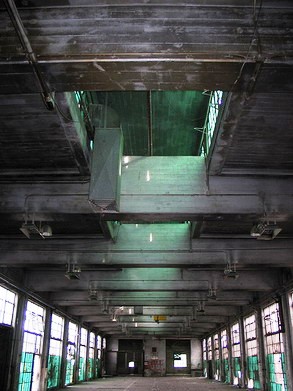 Once construction of diesel engines resumed, the rail yards were still used for repairs but, by the mid-1950’s, the massive complex was mostly utilized for maintaining rail lines. The rail yards were largely a storage facility by the time they were completely shut down in the 1990’s. In November 2007, the City of Albuquerque purchased the site with an aim towards restoration. Since that time some TV shows and movies have been shot in the facility, including Crash and Terminator 4, which I’ve heard is responsible for covering the windows in the fake grime which is still visible.
Once construction of diesel engines resumed, the rail yards were still used for repairs but, by the mid-1950’s, the massive complex was mostly utilized for maintaining rail lines. The rail yards were largely a storage facility by the time they were completely shut down in the 1990’s. In November 2007, the City of Albuquerque purchased the site with an aim towards restoration. Since that time some TV shows and movies have been shot in the facility, including Crash and Terminator 4, which I’ve heard is responsible for covering the windows in the fake grime which is still visible. 
(Photo above was taken from out on the 250-ton overhead crane in the machine shop.)
One goal of restoration is to create a space for the WHEELS Museum, which would act as a repository for much of the rail yard’s history. Of course, the rail yards are too big for one museum, so some sort of mixed-use residential/commercial area is being envisioned, including restaurants, shops and a concert hall. WHEELS fundraisers are being held and meetings with the city continue. At a Rail Yards Advisory Board Meeting early last year, the President of the future WHEELS Museum said the yards contain some of “most important historic buildings in the state of New Mexico.” Here’s to hoping the process of rehabilitation gets underway quickly, before those holes in the roof get any bigger.
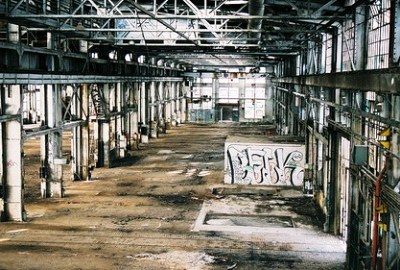
(Photo above is of the boiler shop with overhead crane at the far end.)
Information on the Albuquerque Rail Yard turned out to be pretty hard to find. By far, the best sources were the Wheels Transportation Museum, which has some great content on their WEBSITE, including the best overview of the rail yard’s buildings I could locate.
The other good source was the City of Albuquerque itself, which has some information on the redevelopment plan, including a bit of history.
If you want to get serious about your research, the quote comparing the machine shop to the 1922 Ford Motor Company Glass Plant was from: Grant Hildebrand, Designing for Industry; the Architecture of Albert Ahn, (Cambridge: MIT Press, 1974), pg. 111.

Next post will be on…I have no damn idea, actually.
6 comments:
I like you post have read several of them really like the first one i came across i'm new to blogging but think i like it i really like your post but hard to follow because i have a touch of ADHD LOL
Hey Anonymous,
Thanks for your comment. I appreciate the kind words. Occasionally I manage to write something that's concise and somewhat ADHD-friendly, but often things kind of go on and on. Brevity is something I should strive for!
Thanks again!
John
Keep traveling, keep kicking cans, keep sharing. "AIKEN" having experienced as a mere child, sand gnats in my eyes on the farm near the airport in the late 1940's. Grandmaw making me a cotton sack for me at 4 or 5 out of a feed sack. Your blog puts flesh on the "Valley". Because of you I will pack the Nikon and travel to the farm. A place where the old tin moans in the wind and memories of family reside. Sand, sandspurs, scrub oak and chalk. A place that emotes sorrow and joy. There are Aiken Baptist (kin) who would say its allright they are in heaven. Fuck it is not all right with me, I miss them. PEACE ibrocking
ibrocking, it's comments such as yours that I love getting the most. It was like a little extra something in the stocking on Christmas morning. When it comes to our lives, I guess you can't know true joy without being awfully familiar with sorrow and vice versa.
Of course, you should definitely take the old Nikon to the farm and send some pictures this way, if you can. I'll keep doing what I can, when I can, too.
Thanks again. Your comment means a lot and, geez, when is someone going to start piecing together the history of the Horse Creek Valley? Rumor is that South Carolina PBS is going to air something in early 2011. Let's hope it does the place justice.
Best wishes for 2011.
JM
It is sad to hear that these are the only remaining buildings. Perhaps it could be preserved as a museum and filled with rail-cars, locomotives and railroad memorabilia.
If all goes according to plan, the railyard WILL be preserved. The space is supposed to be restored/redeveloped for commercial and residential purposes, with a museum, as well. Hopefully the redevelopment moves ahead and doesn't alter the basic structure or layout of the complex. The WHEELS MUSEUM is at the forefront of the redevelopment/restoration effort.
Thanks for your comment!
JM
Post a Comment